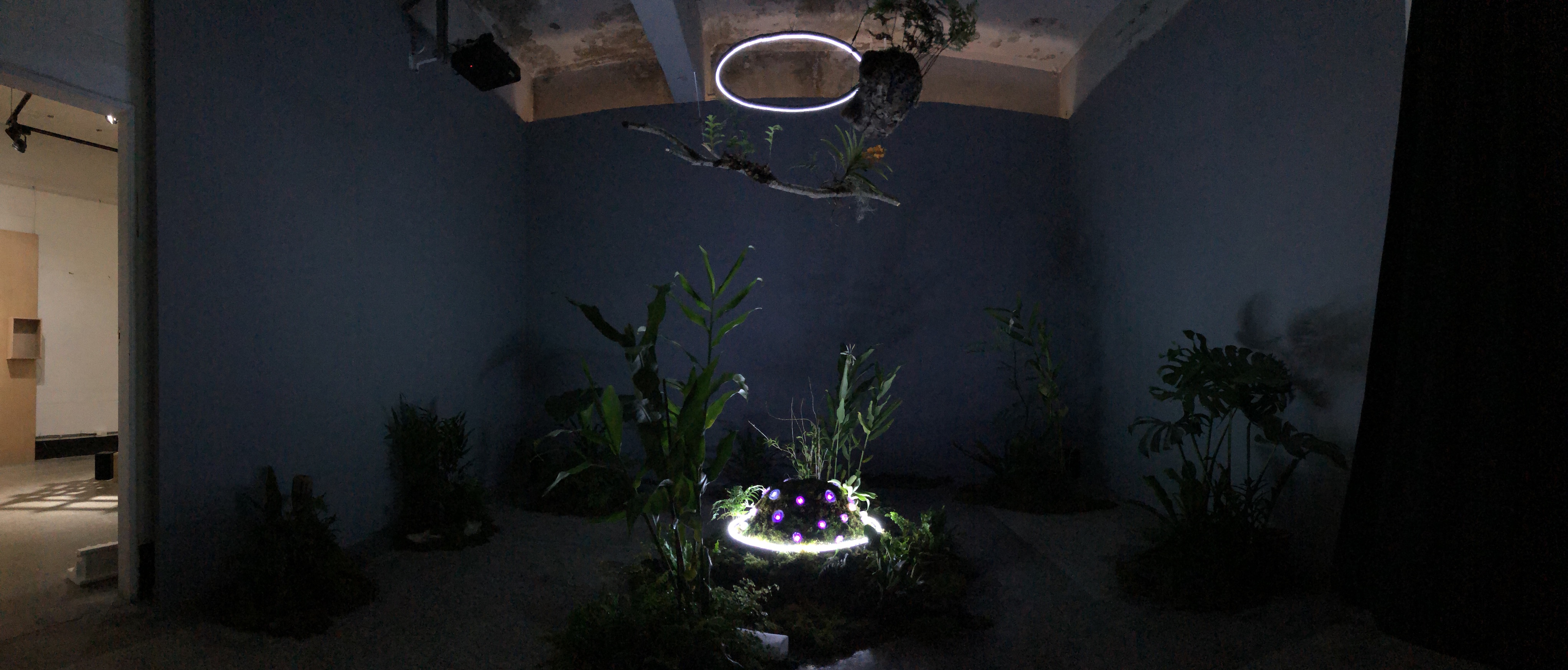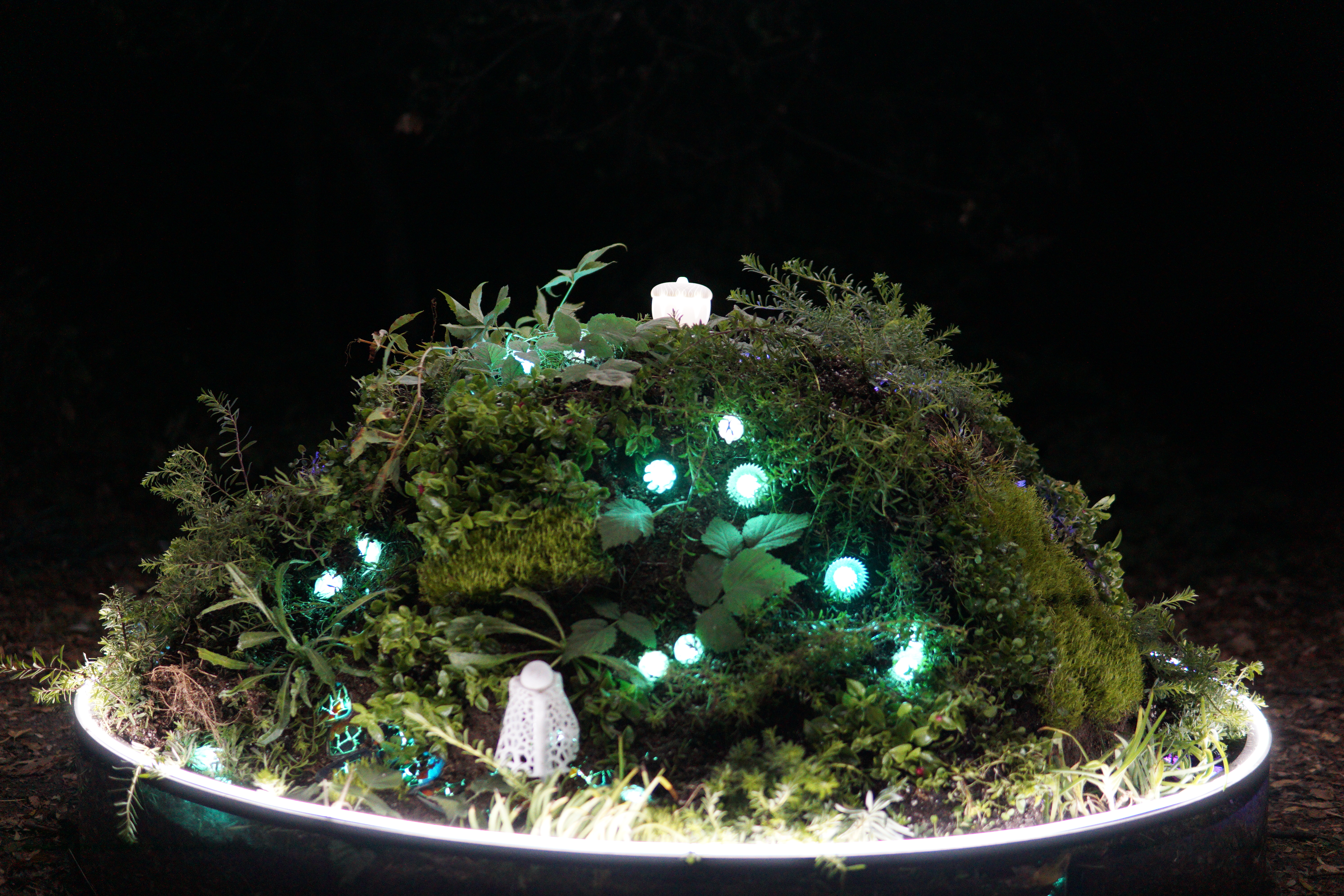Core Sample
Imagine a future of fragility and potential, where the balance of life depends on a single, elemental seed.
 核芯樣本提案模擬圖 Rendering of Core Sample Proposal
核芯樣本提案模擬圖 Rendering of Core Sample Proposal
In 2020, rampant wildfires, the global pandemic, and the Black Lives Matter movement seemed for many to hint at a path toward a dystopian future. For me, however, these events were actually awakening calls, galvanizing my optimism about our future generations. Reacting to that realization, I invited three other collaborators to join me in creating a speculative sculpture—Core Sample, a pneumatic light sculpture installed in the wilderness.
By the year 2100, all of the world’s biomes have endured chaotic shifts in climate: rising sea levels, changing weather patterns, and decades of mass extinction have rendered Earth less hospitable for more living species than during any era since the last ice age (IPCC 2018). In Core Sample we respond to several narratives of ecological collapse, like E. E. Cummings’ poem “pity this busy monster, manunkind,” and Jean Giono’s allegory “L’homme qui plantait des arbres.” Through these lenses, we imagined a portal that opens into the future. In a distant time and place, hundreds of years beyond our catastrophic moment, natural life cohabitates with the new and exotic lifeforms that emerge after the Holocene. Unlike typical core samples—archives of deep time that reveal the world’s intractable past—our core sample summons a future of fragility and potential, where the balance of life depends on a single, elemental seed.
“Core Sample” takes the form of a two-meter-wide column of light. At its center, above a fiberglass shell containing wires, tubes, and pumps, levitates an acorn, glowing by virtue of its own inductive power. The shell is covered in a layer of soil, which supports an ecosystem of both living and pneumatic species. The longer “Core Sample” remains installed in an environment, the more its own ecosystem blends with the native flora around it. We imagine installations in different biomes, of increasing durations, each a unique inquiry into the relationships endemic between nature and technology, plantlife and humanity. As such, “Core Sample” explores what Natasha Myers has called the planthropocene, “an aspirational epoch in which people learn to collaborate with the plants” (Myers 2016), and offers the viewer a glimpse into the enigmatic future of our natural world—and our place within it.
Throughout the project, I managed the budget and timeline and developed the silicone rubber-based pneumatic flowers, the electrical wiring, and cable harnessing, and eventually the programming of the control software. The work was selected from 71 other applications and funded by the Taiwan Ministry of Culture Arts and Technology: Creative Innovation and Counseling Project.

(拍攝最終版的影片前,我們先在加州大學柏克萊分校的校園裡測試安裝,以了解所需的器材與時間。期間遇到許多學生好奇經過,剛好形成一個小型展,大家圍坐在土丘的周圍分享感想。The test install in UC Berkeley Campus)
Responding to “Core Sample” illustrates the power of a single seed to redeem an environment and give new life to even the most impoverished wasteland.
 上方的樹木剛好形成一個拱形,罩著核芯樣本
上方的樹木剛好形成一個拱形,罩著核芯樣本
The primary technical requirement for displaying “Core Sample” is a constant power source. It needs one 120V 15A circuit (or 230V 10A) or sustainable energy source such as solar panels and batteries if connection to the grid is not available. The footprint of the piece is a diameter and height of two meters each, so viewers can walk around it. It needs a hanging structure above for hanging the top ring light (less than 3kg)
We have also shown “Core Sample” in the museum context. The Exhibition in 2020 Digiwave Tech Art Festival in Kaohsiung, Taiwan and the showcase of Taiwan Ministry of Culture Arts and Technology: Creative Innovation and Counseling Project at C-Lab Taipei, Taiwan have given the opportunity for the audience to experience the piece in person in the civil setting.
 高雄駁二特區2020 DigiWave 無條件進位|CeilToInt(); 數位潮科技藝術展
Mini version of Core Sample shown at DigiWave Art and Tech Festival in Kaohsiung, Taiwan
高雄駁二特區2020 DigiWave 無條件進位|CeilToInt(); 數位潮科技藝術展
Mini version of Core Sample shown at DigiWave Art and Tech Festival in Kaohsiung, Taiwan
 高雄駁二特區2020 DigiWave 無條件進位|CeilToInt(); 數位潮科技藝術展
Mini version of Core Sample shown at DigiWave Art and Tech Festival in Kaohsiung, Taiwan
高雄駁二特區2020 DigiWave 無條件進位|CeilToInt(); 數位潮科技藝術展
Mini version of Core Sample shown at DigiWave Art and Tech Festival in Kaohsiung, Taiwan

 科幻原型實驗創作-文化部科技藝術實驗創新及輔導推動計畫階段性成果展實際佈展情況
Mini version of Core Sample shown at C-Lab Taipei, Taiwan
科幻原型實驗創作-文化部科技藝術實驗創新及輔導推動計畫階段性成果展實際佈展情況
Mini version of Core Sample shown at C-Lab Taipei, Taiwan
“Core Sample” is an on-going research project. We want to see how technology and nature can develop a symbiosis relationship, thus we are not only interested in having the piece sitting in nature for a long period of time, but also install it in different natural environments such as rain forest or desert. We are especially interested in how native species react to the appearance of “Core Sample,” growing over and around it ***
The circumstances under which “Core Sample” has come to exist are indeed dire: the understanding of the 2018 report cited above is that it is probably already too late to mitigate many of the catastrophic effects of climate change. But much in the way that the historical core sample doesn’t document the ecological tragedies of the past without also celebrating the new growth that emerged from those moments, “Core Sample” explores the new possibilities that might come to pass in light of an unprecedented and complex future.

What effect will “Core Sample” have on its viewers? With a dangerous yet alluring glow and breath-like movement, “Core Sample” catches the eye of any passer-by. Individually inflating and deflating, the dozens of unique floral elements operate on their own flexible pneumatics, suggesting both a conspicuous independence and also the networked quality of the ecosystem. Drawing upon the light refractive qualities of translucent materials, this animated patch of earth seems as though it were lifted from the bottom of the sea. With radioactive and alien-like flora, this small section of earth presents its viewers with another dimension, and with a single sacrosanct seed of the past. “Core Sample” is its own ecosystem: flowers, fungi, and other plants both draw nourishment from and protect the cherished seed, which itself draws the earth towards it as with preternatural gravity. Fog and light emanate from the living omphalos, offering the viewer a surreal, but also optimistic, view of life in light of endings.

The centerpiece acorn hovers above the landscape of another reality, guarded by the creatures that surround it. By returning one such future to the present through a portal, the piece seeks to imagine, and also appreciate, some of the new forms of life those futures may entail.
「西元 2300 年,世界上所有的⽣態系統將經歷⼀場巨⼤的浩劫:驟變的氣候型態以及⻑期的⽣物滅絕。我們推測在這之後的新世紀將會出現新的⽣命形態,這些新奇的物種將以前所未有的⽅式與⾃然共處 ── 一顆具有平衡生態能量的種子以及其引發的嶄新未來。」
地質學上,核心樣本是科學家用來研究區域歷史的一種方式,在地底下鑽取樣本,分析並觀察不同時期的特性,以了解過去環境的變化。作品「核芯樣本」借用類似的形式,但並非分析過去而是望向未來,像一個傳送門,從未來擷取一塊生態樣本,帶到現代的環境中生長。核心樣本就像是一個窗口,讓人了解未來生態地質特性。
核芯樣本有五個特性(elements),我們希望能透過原型展現這五個元素: 一、神聖性 Divinity 二、生動性 Vitality 三、應變性 Adaptability 四、依存性 Interdependency 五、跨時空性 Interdimensionality
神聖性 Divinity 土丘的正中央是一顆漂浮的橡果,代表著神聖的生命能量,或是新的希望。在Dr.Suess 短篇故事The Lorax的結局,當森林被砍伐光,只剩下最後一個種子,這片土地的未來則是交給種子的擁有者。Core Sample核芯樣本的種子能夠讓貧瘠之地重生,給予生長的能量。雖然看起來種子是被什麼力量撐著而漂浮著,但實際感覺更像是種子的引力將地表拉起來。
生動性 Vitality 種子的周圍是一群像植物又不像植物的奇異生物們,幾乎每個都會發光,溫和的光澤從柔軟的身軀裡散發出來,五顏六色的,充滿生命力的蓬勃生長著。這些物種們似乎都是因神奇種子而生,從其得到能量,也同時在保護它。
應變性 Adaptability 這個土丘上除了來在未來的新物種之外,也存在著當地樹林的植物與菌類,這代表著樣本會因著被傳送到的環境應變,製造當地物種也能夠適應生存的條件。
依存性 Interdependency 這些未來的新物種除了會發光之外,還為進行膨脹又收縮的「呼吸」的動作,每株都有獨特的姿態,同時隨著一樣的節奏搖擺,像是一群舞者,能夠獨自Solo又能相互連結的團體。
跨時空性 Interdimensionality 深藏在森林之中,「核芯樣本」代表著對未來的預見 。在眾多未來之中,這個時間軸代表的未來是令人感到悲觀且不幸的: 氣候變遷造成生物的大滅絕、極端的天氣型態、社會與經濟的崩解、以及對人類—自然關係的重新理解。 對於這樣可悲的現實,「核芯樣本」不只是表達批判,更積極地探索可能存在的一線希望。這塊來自另一個時空的小土丘裡,有著來自外星球的發光花朵、搖擺伸縮的蘑菇、以及漂浮在中心的神聖種子。「核芯樣本」是一個獨立的生態系統 : 所有在這裡的植物與真菌都能夠從寶貴種子得到養分,相對地提供保護的機制,而這反重力的種子力量強大到能將地表向其提升拉近。 從這肚臍般的土丘中散出光與霧,帶給觀者一種超現實但明亮的生命感受。
Date: Oct, 2020
Author: Kuan-Ju Wu, Adam Hutz, Tina Piracci, Barrak Darweesh
